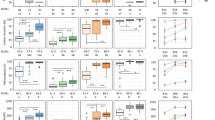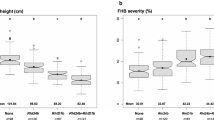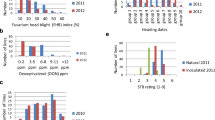Abstract
Fusarium head blight (FHB) is an important disease of wheat worldwide. Soissons is one of the most resistant varieties grown in UK. The current study was undertaken to identify QTL for FHB resistance in Soissons and to determine whether the semi-dwarfing alleles Rht-B1b and Rht-D1b have a similar influence on susceptibility to FHB. A Soissons (Rht-B1b; Rht-D1a) × Orvantis (Rht-B1a; Rht-D1b) doubled haploid (DH) population was assessed for FHB resistance in three trials. Soissons contributed a single, stable major FHB QTL linked to the Rht-D1 locus. In contrast, the Rht-B1b allele (contributed by Soissons) conferred no negative effect on FHB resistance, even conferring a very minor positive effect in one trial. The influence of the Rht-B1b and Rht-D1b alleles on FHB resistance was further investigated using both Mercia and Maris Huntsman near-isogenic lines. Under high disease pressure both Rht-B1b and Rht-D1b significantly decreased Type 1 resistance (resistance to initial infection). However, whilst Rht-D1b has no effect on Type 2 resistance (resistance to spread of the fungus within the spike), Rht-B1b significantly increased Type 2 resistance. Our study demonstrates that the choice of semi-dwarfing gene used in plant breeding programmes may be a significant consideration where resistance to FHB is an important breeding target.

Similar content being viewed by others
References
Buerstmayr H, Steiner B, Lemmens M, Ruckenbauer P (2000) Resistance to Fusarium head blight in winter wheat: heritability and trait associations. Crop Sci 40:1012–1018
Draeger R, Gosman N, Steed A, Chandler E, Thomsett M, Srinivasachary Schondelmaier J, Buerstmayr H, Lemmens M, Schmolke M, Mesterhazy A, Nicholson P (2007) Identification of QTL for resistance to Fusarium head blight, DON accumulation and associated traits in the winter wheat variety Arina. Theor Appl Genet 115:617–625
Ellis MH, Spielmeyer W, Gale KR, Rebetzke GJ, Richards RA (2002) “Perfect” markers for the Rht-B1b and Rht-D1b dwarfing genes in wheat. Theor Appl Genet 105:1038–1042
Flintham JE, Borner A, Worland AJ, Gale MD (1997) Optimising grain yield: effects of Rht (Gibberllin-insensitive) dwarfing genes. J Agric Sci 128:11–25
Gervais L, Dedryver F, Morlais JY, Bodusseau V, Negre S, Bilous M, Groos C, Trottet M (2003) Map** of quantitative trait loci for field resistance to Fusarium head blight in an European winter wheat. Theor Appl Genet 106:961–970
Gilbert J, Tekauz A (2000) Review: recent developments in research on Fusarium head blight of wheat in Canada. Can J Plant Pathol 22:1–8
Gosman N, Chandler E, Thomsett M, Draeger R, Nicholson P (2005) Analysis of the relationship between parameters of resistance to Fusarium head blight and in vitro tolerance to deoxynivalenol of the winter wheat cultivar Wek0609 (R). Eur J Plant Pathol 111:57–66
Gosman N, Bayles R, Jennings P, Kirby J, Nicholson P (2007) Evaluation and characterization of resistance to Fusarium head blight caused by Fusarium culmorum in UK winter wheat cultivars. Plant Pathol 56(2):264–276
Hilton AJ, Jenkinson P, Hollins TW, Parry DW (1999) Relationship between cultivar height and severity of Fusarium ear blight in wheat. Plant Pathol 48:202–208
Jaccoud D, Peng K, Feinstein D, Kilian A (2001) Diversity arrays: a solid state technology for sequence information independent genoty**. Nucl Acids Res 29:e25
Klahr A, Zimmermann G, Wenzel G, Mohler V (2007) Effects of environment, disease progress, plant height and heading date on the detection of QTL for resistance to Fusarium head blight in an European winter wheat cross. Euphytica 154:17–28
Kosambi DD (1944) The estimation of map values from recombination value. Ann Eugen 12:172–175
Laurie DA, Reymondie S (1991) High frequencies of fertilization and haploid seedling production in crosses between commercial hexaploid wheat varieties and maize. Plant Breed 106:182–189
Mesterhazy A (1995) Types and components of resistance to Fusarium head blight of wheat. Plant Breed 114:377–386
Miedaner T (1997) Breeding wheat and rye for resistance to Fusarium diseases. Plant Breed 116:201–220
Nyquist WE (1991) Estimation of heritability and prediction of selection response in plant populations. CRC Crit Rev Plant Sci 10(3):235–322
Paillard S, Schnurbusch T, Tiwari R, Messmer M, Winzeler M, Keller B, Schachermayr G (2004) QTL analysis of resistance to Fusarium head blight in Swiss winter wheat (Triticum aestivum L.). Theor Appl Genet 109:323–332
Parry DW, Jenkinson P, McLeod L (1995) Fusarium ear blight (scab) in small grain cereals—a review. Plant Pathol 44:207–238
Schmolke M, Zimmermann G, Buerstmayr H, Schweizer G, Miedaner T, Korzun V, Ebmeyer E, Hartl L (2005) Molecular map** of Fusarium head blight resistance in the winter wheat population Dream/Lynx. Theor Appl Genet 111:747–756
Schroeder HW, Christensen JJ (1963) Factors affecting resistance of wheat to scab caused by Gibberella zeae. Phytopathology 53:831–838
Semagn K, Skinnes H, Bjornstad A, Maroy AG, Tarkegne Y (2007) Quantitative trait loci controlling Fusarium head blight resistance and low deoxynivalenol content in hexaploid wheat population from ‘Arina’ and NK93604. Crop Sci 47:294–303
Shen R, Kong LR, Ohm H (2004) Fusarium head blight resistance in hexaploid wheat (Triticum aestivum)–Lophopyrum genetic lines and tagging of the alien chromatin by PCR markers. Theor Appl Genet 108:808–813
Somers DJ, Fedak G, Savard M (2003) Molecular map** of novel genes controlling Fusarium head blight resistance and deoxynivalenol accumulation in spring wheat. Genome 46(4):555–564
Srinivasachary, Gosman N, Steed A, Simmonds J, Leverington-Waite M, Wang Y, Snape J, Nicholson P (2008) Susceptibility to Fusarium head blight is associated with the Rht-D1b semi-dwarfing allele in wheat. Theor Appl Genet 116:1145–1153
Steiner B, Lemmens M, Griesser M, Scholz U, Schondelmaier J, Buerstmayr H (2004) Molecular map** of resistance to Fusarium head blight in the spring wheat cultivar Frontana. Theor Appl Genet 109:215–224
Van Ooijen JW (2004) MapQTL Version 5.0, Software for the map** of quantitative trait loci in experimental populations. Kyazma B.V, Wageningen
Van Ooijen JW, Voorips RE (2001) JoinMap 3.0. Software for the calculation of genetic linkage maps. Plant Research International, Wageningen
Voorrips RE (2002) MAPCHART: Software for the graphical presentation of linkage maps and QTL. Heredity 93:77–78
Waldron BL, Moreno-Sevilla B, Anderson JA, Stack RW, Frohberg RC (1999) RFLP map** of QTL for Fusarium head blight resistance in Wheat. Crop Sci 39:805–811
Zadoks JC, Chang TT, Konzak CF (1974) Decimal code for growth stages of cereals. Weed Res 14:415–421
Acknowledgments
We wish to express our sincere gratitude to UK Home-Grown Cereals Authority (HGCA) and the Department of Environment, Food and Rural Affairs (Defra) through a Defra-LINK project (No. LK0932). All the authors would like to thank collaborating commercial partners Nickerson (UK) Ltd., Elsoms Seeds Ltd., Advanta Seeds (UK) Ltd. and RAGT Seeds Ltd. (collaboration initiated with Monsanto (UK) Ltd., who subsequently transferred their wheat breeding programme to RAGT) for their invaluable contributions and for all those involved in field and polytunnel related work. We also thank Dr. Marc Ellis, CSIRO, Australia, for providing unpublished protocols for genoty** Rht1 and Rht2.
Author information
Authors and Affiliations
Corresponding author
Additional information
Communicated by B. Keller.
Rights and permissions
About this article
Cite this article
Srinivasachary, Gosman, N., Steed, A. et al. Semi-dwarfing Rht-B1 and Rht-D1 loci of wheat differ significantly in their influence on resistance to Fusarium head blight. Theor Appl Genet 118, 695–702 (2009). https://doi.org/10.1007/s00122-008-0930-0
Received:
Accepted:
Published:
Issue Date:
DOI: https://doi.org/10.1007/s00122-008-0930-0




